Manipulating Topological Phases in Magnetic Topological Insulators
Abstract
:1. Introduction
1.1. Material Platforms
1.1.1. Magnetically Doped TIs
1.1.2. Intrinsic Magnetic Topological Insulators
1.1.3. Twisted Moiré Materials
1.2. Topological States in Magnetic Topological Insulators
1.2.1. Axion Insulators
1.2.2. Chern Insulators with High Chern Numbers
1.2.3. Magnetic Weyl Semimetals
2. Scaling Behavior during Quantum Phase Transitions in Finite-Sized MTIs
3. Pressure Tuning of Topological Phases
4. Electric Field Tuning of Topological Phases
4.1. Theoretical Models
4.2. Experimental Observations
4.2.1. Magnetic Phase Transition
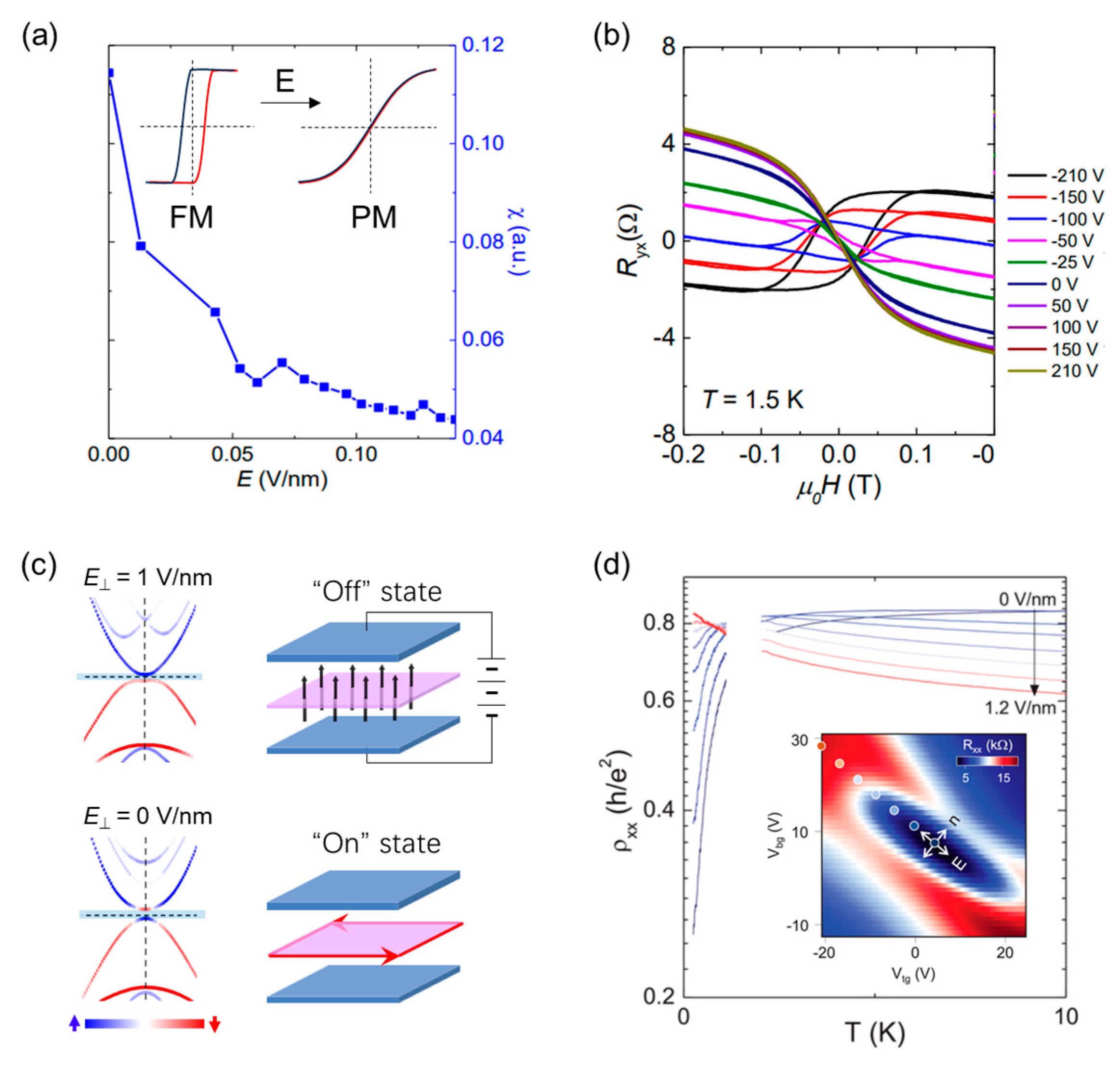
4.2.2. Topological Phase Transition
4.3. Electric Field-Controlled Topological Transitions
5. Interface Tuning and Proximity Effect
6. Conclusions and Outlooks
Author Contributions
Funding
Data Availability Statement
Conflicts of Interest
References
- Klitzing, K.v.; Dorda, G.; Pepper, M. New Method for High-Accuracy Determination of the Fine-Structure Constant Based on Quantized Hall Resistance. Phys. Rev. Lett. 1980, 45, 494–497. [Google Scholar] [CrossRef]
- Kohmoto, M. Topological invariant and the quantization of the Hall conductance. Ann. Phys. 1985, 160, 343–354. [Google Scholar] [CrossRef]
- Thouless, D.J.; Kohmoto, M.; Nightingale, M.P.; den Nijs, M. Quantized Hall Conductance in a Two-Dimensional Periodic Potential. Phys. Rev. Lett. 1982, 49, 405–408. [Google Scholar] [CrossRef]
- Zhang, H.; Liu, C.-X.; Qi, X.-L.; Dai, X.; Fang, Z.; Zhang, S.-C. Topological insulators in Bi2Se3, Bi2Te3 and Sb2Te3 with a single Dirac cone on the surface. Nat. Phys. 2009, 5, 438–442. [Google Scholar] [CrossRef]
- Chen, Y.L.; Analytis, J.G.; Chu, J.-H.; Liu, Z.K.; Mo, S.-K.; Qi, X.L.; Zhang, H.J.; Lu, D.H.; Dai, X.; Fang, Z.; et al. Experimental Realization of a Three-Dimensional Topological Insulator, Bi2Te3. Science 2009, 325, 178–181. [Google Scholar] [CrossRef]
- Fu, L.; Kane, C.L. Topological insulators with inversion symmetry. Phys. Rev. B 2007, 76, 045302. [Google Scholar] [CrossRef]
- Fu, L.; Kane, C.L.; Mele, E.J. Topological Insulators in Three Dimensions. Phys. Rev. Lett. 2007, 98, 106803. [Google Scholar] [CrossRef]
- Kane, C.L.; Mele, E.J. Quantum Spin Hall Effect in Graphene. Phys. Rev. Lett. 2005, 95, 226801. [Google Scholar] [CrossRef]
- Kane, C.L.; Mele, E.J. Z2 Topological Order and the Quantum Spin Hall Effect. Phys. Rev. Lett. 2005, 95, 146802. [Google Scholar] [CrossRef]
- König, M.; Wiedmann, S.; Brüne, C.; Roth, A.; Buhmann, H.; Molenkamp, L.W.; Qi, X.-L.; Zhang, S.-C. Quantum Spin Hall Insulator State in HgTe Quantum Wells. Science 2007, 318, 766–770. [Google Scholar] [CrossRef]
- Chang, C.-Z.; Liu, C.-X.; MacDonald, A.H. Colloquium: Quantum anomalous Hall effect. Rev. Mod. Phys. 2023, 95, 011002. [Google Scholar] [CrossRef]
- Liu, C.-X.; Zhang, S.-C.; Qi, X.-L. The Quantum Anomalous Hall Effect: Theory and Experiment. Annu. Rev. Condens. Matter Phys. 2016, 7, 301–321. [Google Scholar] [CrossRef]
- Kou, X.; Fan, Y.; Wang, K.L. Review of Quantum Hall Trio. J. Phys. Chem. Solids 2019, 128, 2–23. [Google Scholar] [CrossRef]
- Haldane, F.D.M. Model for a Quantum Hall Effect without Landau Levels: Condensed-Matter Realization of the “Parity Anomaly”. Phys. Rev. Lett. 1988, 61, 2015–2018. [Google Scholar] [CrossRef] [PubMed]
- Liu, C.-X.; Qi, X.-L.; Dai, X.; Fang, Z.; Zhang, S.-C. Quantum Anomalous Hall Effect in Hg1−yMnyTe Quantum Wells. Phys. Rev. Lett. 2008, 101, 146802. [Google Scholar] [CrossRef]
- Yu, R.; Zhang, W.; Zhang, H.-J.; Zhang, S.-C.; Dai, X.; Fang, Z. Quantized Anomalous Hall Effect in Magnetic Topological Insulators. Science 2010, 329, 61–64. [Google Scholar] [CrossRef]
- Tokura, Y.; Yasuda, K.; Tsukazaki, A. Magnetic topological insulators. Nat. Rev. Phys. 2019, 1, 126–143. [Google Scholar] [CrossRef]
- Wang, P.; Ge, J.; Li, J.; Liu, Y.; Xu, Y.; Wang, J. Intrinsic magnetic topological insulators. Innovation 2021, 2, 100098. [Google Scholar] [CrossRef]
- Kou, X.; Fan, Y.; Lang, M.; Upadhyaya, P.; Wang, K.L. Magnetic topological insulators and quantum anomalous hall effect. Solid State Commun. 2015, 215–216, 34–53. [Google Scholar] [CrossRef]
- He, K.; Wang, Y.; Xue, Q.-K. Topological Materials: Quantum Anomalous Hall System. Annu. Rev. Condens. Matter Phys. 2018, 9, 329–344. [Google Scholar] [CrossRef]
- Chang, C.-Z.; Li, M. Quantum anomalous Hall effect in time-reversal-symmetry breaking topological insulators. J. Phys. Condens. Matter 2016, 28, 123002. [Google Scholar] [CrossRef] [PubMed]
- Chen, Y.L.; Chu, J.H.; Analytis, J.G.; Liu, Z.K.; Igarashi, K.; Kuo, H.H.; Qi, X.L.; Mo, S.K.; Moore, R.G.; Lu, D.H.; et al. Massive Dirac Fermion on the Surface of a Magnetically Doped Topological Insulator. Science 2010, 329, 659–662. [Google Scholar] [CrossRef] [PubMed]
- Chang, C.-Z.; Tang, P.; Wang, Y.-L.; Feng, X.; Li, K.; Zhang, Z.; Wang, Y.; Wang, L.-L.; Chen, X.; Liu, C.; et al. Chemical-Potential-Dependent Gap Opening at the Dirac Surface States of Bi2Se3 Induced by Aggregated Substitutional Cr Atoms. Phys. Rev. Lett. 2014, 112, 056801. [Google Scholar] [CrossRef] [PubMed]
- Chang, C.-Z.; Zhang, J.; Feng, X.; Shen, J.; Zhang, Z.; Guo, M.; Li, K.; Ou, Y.; Wei, P.; Wang, L.-L.; et al. Experimental Observation of the Quantum Anomalous Hall Effect in a Magnetic Topological Insulator. Science 2013, 340, 167–170. [Google Scholar] [CrossRef] [PubMed]
- Kou, X.; Guo, S.-T.; Fan, Y.; Pan, L.; Lang, M.; Jiang, Y.; Shao, Q.; Nie, T.; Murata, K.; Tang, J.; et al. Scale-Invariant Quantum Anomalous Hall Effect in Magnetic Topological Insulators beyond the Two-Dimensional Limit. Phys. Rev. Lett. 2014, 113, 137201. [Google Scholar] [CrossRef] [PubMed]
- Checkelsky, J.G.; Yoshimi, R.; Tsukazaki, A.; Takahashi, K.S.; Kozuka, Y.; Falson, J.; Kawasaki, M.; Tokura, Y. Trajectory of the anomalous Hall effect towards the quantized state in a ferromagnetic topological insulator. Nat. Phys. 2014, 10, 731–736. [Google Scholar] [CrossRef]
- Chang, C.-Z.; Zhao, W.; Kim, D.Y.; Zhang, H.; Assaf, B.A.; Heiman, D.; Zhang, S.-C.; Liu, C.; Chan, M.H.W.; Moodera, J.S. High-precision realization of robust quantum anomalous Hall state in a hard ferromagnetic topological insulator. Nat. Mater. 2015, 14, 473–477. [Google Scholar] [CrossRef]
- Rodenbach, L.K.; Panna, A.R.; Payagala, S.U.; Rosen, I.T.; Andersen, M.P.; Zhang, P.; Tai, L.; Wang, K.L.; Jarrett, D.G.; Elmquist, R.E.; et al. Metrological Assessment of Quantum Anomalous Hall Properties. Phys. Rev. Appl. 2022, 18, 034008. [Google Scholar] [CrossRef]
- Fox, E.J.; Rosen, I.T.; Yang, Y.; Jones, G.R.; Elmquist, R.E.; Kou, X.; Pan, L.; Wang, K.L.; Goldhaber-Gordon, D. Part-per-million quantization and current-induced breakdown of the quantum anomalous Hall effect. Phys. Rev. B 2018, 98, 075145. [Google Scholar] [CrossRef]
- Okazaki, Y.; Oe, T.; Kawamura, M.; Yoshimi, R.; Nakamura, S.; Takada, S.; Mogi, M.; Takahashi, K.S.; Tsukazaki, A.; Kawasaki, M.; et al. Quantum anomalous Hall effect with a permanent magnet defines a quantum resistance standard. Nat. Phys. 2022, 18, 25–29. [Google Scholar] [CrossRef]
- Li, W.; Claassen, M.; Chang, C.-Z.; Moritz, B.; Jia, T.; Zhang, C.; Rebec, S.; Lee, J.J.; Hashimoto, M.; Lu, D.H.; et al. Origin of the low critical observing temperature of the quantum anomalous Hall effect in V-doped (Bi, Sb)2Te3 film. Sci. Rep. 2016, 6, 32732. [Google Scholar] [CrossRef] [PubMed]
- Lee, I.; Kim, C.K.; Lee, J.; Billinge, S.J.L.; Zhong, R.; Schneeloch, J.A.; Liu, T.; Valla, T.; Tranquada, J.M.; Gu, G.; et al. Imaging Dirac-mass disorder from magnetic dopant atoms in the ferromagnetic topological insulator Crx(Bi0.1Sb0.9)2−xTe3. Proc. Natl. Acad. Sci. USA 2015, 112, 1316–1321. [Google Scholar] [CrossRef] [PubMed]
- Otrokov, M.M.; Klimovskikh, I.I.; Bentmann, H.; Estyunin, D.; Zeugner, A.; Aliev, Z.S.; Gaß, S.; Wolter, A.U.B.; Koroleva, A.V.; Shikin, A.M.; et al. Prediction and observation of an antiferromagnetic topological insulator. Nature 2019, 576, 416–422. [Google Scholar] [CrossRef] [PubMed]
- Li, J.; Li, Y.; Du, S.; Wang, Z.; Gu, B.-L.; Zhang, S.-C.; He, K.; Duan, W.; Xu, Y. Intrinsic magnetic topological insulators in van der Waals layered MnBi2Te4-family materials. Sci. Adv. 2019, 5, eaaw5685. [Google Scholar] [CrossRef]
- Deng, Y.; Yu, Y.; Shi, M.Z.; Guo, Z.; Xu, Z.; Wang, J.; Chen, X.H.; Zhang, Y. Quantum anomalous Hall effect in intrinsic magnetic topological insulator MnBi2Te4. Science 2020, 367, 895–900. [Google Scholar] [CrossRef]
- Sharpe, A.L.; Fox, E.J.; Barnard, A.W.; Finney, J.; Watanabe, K.; Taniguchi, T.; Kastner, M.A.; Goldhaber-Gordon, D. Emergent ferromagnetism near three-quarters filling in twisted bilayer graphene. Science 2019, 365, 605–608. [Google Scholar] [CrossRef]
- Serlin, M.; Tschirhart, C.L.; Polshyn, H.; Zhang, Y.; Zhu, J.; Watanabe, K.; Taniguchi, T.; Balents, L.; Young, A.F. Intrinsic quantized anomalous Hall effect in a moiré heterostructure. Science 2020, 367, 900–903. [Google Scholar] [CrossRef]
- Chen, G.; Sharpe, A.L.; Fox, E.J.; Zhang, Y.-H.; Wang, S.; Jiang, L.; Lyu, B.; Li, H.; Watanabe, K.; Taniguchi, T.; et al. Tunable correlated Chern insulator and ferromagnetism in a moiré superlattice. Nature 2020, 579, 56–61. [Google Scholar] [CrossRef]
- Park, H.; Cai, J.; Anderson, E.; Zhang, Y.; Zhu, J.; Liu, X.; Wang, C.; Holtzmann, W.; Hu, C.; Liu, Z.; et al. Observation of Fractionally Quantized Anomalous Hall Effect. Nature 2023. [Google Scholar] [CrossRef]
- Cai, J.; Anderson, E.; Wang, C.; Zhang, X.; Liu, X.; Holtzmann, W.; Zhang, Y.; Fan, F.; Taniguchi, T.; Watanabe, K.; et al. Signatures of Fractional Quantum Anomalous Hall States in Twisted MoTe2. Nature 2023. [Google Scholar] [CrossRef]
- Zeng, Y.; Xia, Z.; Kang, K.; Zhu, J.; Knüppel, P.; Vaswani, C.; Watanabe, K.; Taniguchi, T.; Mak, K.F.; Shan, J. Thermodynamic evidence of fractional Chern insulator in moiré MoTe2. Nature 2023. [Google Scholar] [CrossRef] [PubMed]
- Li, T.; Jiang, S.; Shen, B.; Zhang, Y.; Li, L.; Tao, Z.; Devakul, T.; Watanabe, K.; Taniguchi, T.; Fu, L.; et al. Quantum anomalous Hall effect from intertwined moiré bands. Nature 2021, 600, 641–646. [Google Scholar] [CrossRef] [PubMed]
- Wilczek, F. Two applications of axion electrodynamics. Phys. Rev. Lett. 1987, 58, 1799–1802. [Google Scholar] [CrossRef] [PubMed]
- Wang, J.; Lian, B.; Qi, X.-L.; Zhang, S.-C. Quantized topological magnetoelectric effect of the zero-plateau quantum anomalous Hall state. Phys. Rev. B 2015, 92, 081107. [Google Scholar] [CrossRef]
- Morimoto, T.; Furusaki, A.; Nagaosa, N. Topological magnetoelectric effects in thin films of topological insulators. Phys. Rev. B 2015, 92, 085113. [Google Scholar] [CrossRef]
- Kou, X.; Pan, L.; Wang, J.; Fan, Y.; Choi, E.S.; Lee, W.-L.; Nie, T.; Murata, K.; Shao, Q.; Zhang, S.-C.; et al. Metal-to-insulator switching in quantum anomalous Hall states. Nat. Commun. 2015, 6, 8474. [Google Scholar] [CrossRef]
- Mogi, M.; Kawamura, M.; Tsukazaki, A.; Yoshimi, R.; Takahashi, K.S.; Kawasaki, M.; Tokura, Y. Tailoring tricolor structure of magnetic topological insulator for robust axion insulator. Sci. Adv. 2017, 3, eaao1669. [Google Scholar] [CrossRef]
- Xiao, D.; Jiang, J.; Shin, J.-H.; Wang, W.; Wang, F.; Zhao, Y.-F.; Liu, C.; Wu, W.; Chan, M.H.W.; Samarth, N.; et al. Realization of the Axion Insulator State in Quantum Anomalous Hall Sandwich Heterostructures. Phys. Rev. Lett. 2018, 120, 056801. [Google Scholar] [CrossRef]
- Mogi, M.; Yoshimi, R.; Tsukazaki, A.; Yasuda, K.; Kozuka, Y.; Takahashi, K.S.; Kawasaki, M.; Tokura, Y. Magnetic modulation doping in topological insulators toward higher-temperature quantum anomalous Hall effect. Appl. Phys. Lett. 2015, 107, 182401. [Google Scholar] [CrossRef]
- Zhao, Y.-F.; Zhang, R.; Mei, R.; Zhou, L.-J.; Yi, H.; Zhang, Y.-Q.; Yu, J.; Xiao, R.; Wang, K.; Samarth, N.; et al. Tuning the Chern number in quantum anomalous Hall insulators. Nature 2020, 588, 419–423. [Google Scholar] [CrossRef]
- Zhao, Y.-F.; Zhang, R.; Zhou, L.-J.; Mei, R.; Yan, Z.-J.; Chan, M.H.W.; Liu, C.-X.; Chang, C.-Z. Zero Magnetic Field Plateau Phase Transition in Higher Chern Number Quantum Anomalous Hall Insulators. Phys. Rev. Lett. 2022, 128, 216801. [Google Scholar] [CrossRef] [PubMed]
- Wan, X.; Turner, A.M.; Vishwanath, A.; Savrasov, S.Y. Topological semimetal and Fermi-arc surface states in the electronic structure of pyrochlore iridates. Phys. Rev. B 2011, 83, 205101. [Google Scholar] [CrossRef]
- Sanchez, D.S.; Chang, G.; Belopolski, I.; Lu, H.; Yin, J.-X.; Alidoust, N.; Xu, X.; Cochran, T.A.; Zhang, X.; Bian, Y.; et al. Observation of Weyl fermions in a magnetic non-centrosymmetric crystal. Nat. Commun. 2020, 11, 3356. [Google Scholar] [CrossRef] [PubMed]
- Yang, K.-Y.; Lu, Y.-M.; Ran, Y. Quantum Hall effects in a Weyl semimetal: Possible application in pyrochlore iridates. Phys. Rev. B 2011, 84, 075129. [Google Scholar] [CrossRef]
- Muechler, L.; Liu, E.; Gayles, J.; Xu, Q.; Felser, C.; Sun, Y. Emerging chiral edge states from the confinement of a magnetic Weyl semimetal in Co3Sn2S2. Phys. Rev. B 2020, 101, 115106. [Google Scholar] [CrossRef]
- Qiu, G.; Zhang, P.; Deng, P.; Chong, S.K.; Tai, L.; Eckberg, C.; Wang, K.L. Mesoscopic Transport of Quantum Anomalous Hall Effect in the Submicron Size Regime. Phys. Rev. Lett. 2022, 128, 217704. [Google Scholar] [CrossRef]
- Zhou, L.-J.; Mei, R.; Zhao, Y.-F.; Zhang, R.; Zhuo, D.; Yan, Z.-J.; Yuan, W.; Kayyalha, M.; Chan, M.H.W.; Liu, C.-X.; et al. Confinement-Induced Chiral Edge Channel Interaction in Quantum Anomalous Hall Insulators. Phys. Rev. Lett. 2023, 130, 086201. [Google Scholar] [CrossRef]
- Fijalkowski, K.M.; Liu, N.; Mandal, P.; Schreyeck, S.; Brunner, K.; Gould, C.; Molenkamp, L.W. Macroscopic Quantum Tunneling of a Topological Ferromagnet. Adv. Sci. 2023, 10, 2303165. [Google Scholar] [CrossRef]
- Weis, J.; von Klitzing, K. Metrology and microscopic picture of the integer quantum Hall effect. Philos. Trans. R. Soc. A Math. Phys. Eng. Sci. 2011, 369, 3954–3974. [Google Scholar] [CrossRef]
- Panos, K.; Gerhardts, R.R.; Weis, J.; Klitzing, K.v. Current distribution and Hall potential landscape towards breakdown of the quantum Hall effect: A scanning force microscopy investigation. New J. Phys. 2014, 16, 113071. [Google Scholar] [CrossRef]
- Haremski, P.; Mausser, M.; Gauß, A.; von Klitzing, K.; Weis, J. Electrically induced breakdown of the quantum Hall effect at different Hall bar widths: Visualizing the edge- and bulk-dominated regimes within a quantum Hall plateau. Phys. Rev. B 2020, 102, 205306. [Google Scholar] [CrossRef]
- Deng, P.; Eckberg, C.; Zhang, P.; Qiu, G.; Emmanouilidou, E.; Yin, G.; Chong, S.K.; Tai, L.; Ni, N.; Wang, K.L. Probing the mesoscopic size limit of quantum anomalous Hall insulators. Nat. Commun. 2022, 13, 4246. [Google Scholar] [CrossRef]
- Ideue, T.; Hirayama, M.; Taiko, H.; Takahashi, T.; Murase, M.; Miyake, T.; Murakami, S.; Sasagawa, T.; Iwasa, Y. Pressure-induced topological phase transition in noncentrosymmetric elemental tellurium. Proc. Natl. Acad. Sci. USA 2019, 116, 25530–25534. [Google Scholar] [CrossRef] [PubMed]
- Kang, L.; Cao, Z.-Y.; Wang, B. Pressure-Induced Electronic Topological Transition and Superconductivity in Topological Insulator Bi2Te2.1Se0.9. J. Phys. Chem. Lett. 2022, 13, 11521–11527. [Google Scholar] [CrossRef] [PubMed]
- Zhu, J.; Zhang, J.L.; Kong, P.P.; Zhang, S.J.; Yu, X.H.; Zhu, J.L.; Liu, Q.Q.; Li, X.; Yu, R.C.; Ahuja, R.; et al. Superconductivity in Topological Insulator Sb2Te3 Induced by Pressure. Sci. Rep. 2013, 3, 2016. [Google Scholar] [CrossRef] [PubMed]
- Bahramy, M.S.; Yang, B.J.; Arita, R.; Nagaosa, N. Emergence of non-centrosymmetric topological insulating phase in BiTeI under pressure. Nat. Commun. 2012, 3, 679. [Google Scholar] [CrossRef]
- Xi, X.; Ma, C.; Liu, Z.; Chen, Z.; Ku, W.; Berger, H.; Martin, C.; Tanner, D.B.; Carr, G.L. Signatures of a Pressure-Induced Topological Quantum Phase Transition in BiTeI. Phys. Rev. Lett. 2013, 111, 155701. [Google Scholar] [CrossRef]
- Liu, Y.; Li, Y.Y.; Rajput, S.; Gilks, D.; Lari, L.; Galindo, P.L.; Weinert, M.; Lazarov, V.K.; Li, L. Tuning Dirac states by strain in the topological insulator Bi2Se3. Nat. Phys. 2014, 10, 294–299. [Google Scholar] [CrossRef]
- Liang, T.; Kushwaha, S.; Kim, J.; Gibson, Q.; Lin, J.; Kioussis, N.; Cava, R.J.; Ong, N.P. A pressure-induced topological phase with large Berry curvature in Pb1−xSnxTe. Sci. Adv. 2017, 3, e1602510. [Google Scholar] [CrossRef]
- Manjón, F.J.; Vilaplana, R.; Gomis, O.; Pérez-González, E.; Santamaría-Pérez, D.; Marín-Borrás, V.; Segura, A.; González, J.; Rodríguez-Hernández, P.; Muñoz, A.; et al. High-pressure studies of topological insulators Bi2Se3, Bi2Te3, and Sb2Te3. Phys. Status Solidi (b) 2013, 250, 669–676. [Google Scholar] [CrossRef]
- Awaga, K.; Maruyama, Y. High-pressure effects on the canted ferromagnetism in manganese(II) phthalocyanine. Phys. Rev. B 1991, 44, 2589–2594. [Google Scholar] [CrossRef] [PubMed]
- Lin, Z.; Lohmann, M.; Ali, Z.A.; Tang, C.; Li, J.; Xing, W.; Zhong, J.; Jia, S.; Han, W.; Coh, S.; et al. Pressure-induced spin reorientation transition in layered ferromagnetic insulator Cr2Ge2Te6. Phys. Rev. Mater. 2018, 2, 051004. [Google Scholar] [CrossRef]
- Mondal, S.; Kannan, M.; Das, M.; Govindaraj, L.; Singha, R.; Satpati, B.; Arumugam, S.; Mandal, P. Effect of hydrostatic pressure on ferromagnetism in two-dimensional CrI3. Phys. Rev. B 2019, 99, 180407. [Google Scholar] [CrossRef]
- Baidya, S.; Yu, J.; Kim, C.H. Tunable magnetic topological insulating phases in monolayer CrI3. Phys. Rev. B 2018, 98, 155148. [Google Scholar] [CrossRef]
- Song, T.; Fei, Z.; Yankowitz, M.; Lin, Z.; Jiang, Q.; Hwangbo, K.; Zhang, Q.; Sun, B.; Taniguchi, T.; Watanabe, K.; et al. Switching 2D magnetic states via pressure tuning of layer stacking. Nat. Mater. 2019, 18, 1298–1302. [Google Scholar] [CrossRef]
- Li, T.; Jiang, S.; Sivadas, N.; Wang, Z.; Xu, Y.; Weber, D.; Goldberger, J.E.; Watanabe, K.; Taniguchi, T.; Fennie, C.J.; et al. Pressure-controlled interlayer magnetism in atomically thin CrI3. Nat. Mater. 2019, 18, 1303–1308. [Google Scholar] [CrossRef]
- Eckberg, C.; Qiu, G.; Qu, T.; Kwon, S.; Liu, Y.; Tai, L.; Graf, D.; Chong, S.K.; Zhang, P.; Wong, K.L. Structural tuning magnetism and topology in a magnetic topological insulator. arXiv 2023, arXiv:2301.03078. [Google Scholar]
- Vilaplana, R.; Santamaría-Pérez, D.; Gomis, O.; Manjón, F.J.; González, J.; Segura, A.; Muñoz, A.; Rodríguez-Hernández, P.; Pérez-González, E.; Marín-Borrás, V.; et al. Structural and vibrational study of Bi2Se3 under high pressure. Phys. Rev. B 2011, 84, 184110. [Google Scholar] [CrossRef]
- Kirshenbaum, K.; Syers, P.S.; Hope, A.P.; Butch, N.P.; Jeffries, J.R.; Weir, S.T.; Hamlin, J.J.; Maple, M.B.; Vohra, Y.K.; Paglione, J. Pressure-Induced Unconventional Superconducting Phase in the Topological Insulator Bi2Se3. Phys. Rev. Lett. 2013, 111, 087001. [Google Scholar] [CrossRef]
- Chong, S.K.; Lei, C.; Li, J.; Cheng, Y.; Graf, D.; Lee, S.H.; Tanabe, M.; Yang, T.-H.; Mao, Z.; MacDonald, A.H. Pressure tunable quantum anomalous Hall states in a topological antiferromagnet. arXiv 2023, arXiv:2306.10325. [Google Scholar]
- Wang, J.; Lian, B.; Zhang, S.-C. Electrically Tunable Magnetism in Magnetic Topological Insulators. Phys. Rev. Lett. 2015, 115, 036805. [Google Scholar] [CrossRef] [PubMed]
- Wang, J. Electrically tunable topological superconductivity and Majorana fermions in two dimensions. Phys. Rev. B 2016, 94, 214502. [Google Scholar] [CrossRef]
- Li, J.; Wu, R. Electrically Tunable Topological Phase Transition in van der Waals Heterostructures. Nano Lett. 2023, 23, 2173. [Google Scholar] [CrossRef] [PubMed]
- Li, H.; Sheng, L.; Xing, D.Y. Quantum phase transitions in ultrathin films of three-dimensional topological insulators in the presence of an electrostatic potential and a Zeeman field. Phys. Rev. B 2012, 85, 045118. [Google Scholar] [CrossRef]
- Zhang, Z.; Feng, X.; Wang, J.; Lian, B.; Zhang, J.; Chang, C.; Guo, M.; Ou, Y.; Feng, Y.; Zhang, S.-C.; et al. Magnetic quantum phase transition in Cr-doped Bi2(SexTe1−x)3 driven by the Stark effect. Nat. Nanotechnol. 2017, 12, 953–957. [Google Scholar] [CrossRef] [PubMed]
- Wang, Z.; Zhang, T.; Ding, M.; Dong, B.; Li, Y.; Chen, M.; Li, X.; Huang, J.; Wang, H.; Zhao, X.; et al. Electric-field control of magnetism in a few-layered van der Waals ferromagnetic semiconductor. Nat. Nanotechnol. 2018, 13, 554–559. [Google Scholar] [CrossRef]
- Zhang, Z.; Feng, X.; Guo, M.; Li, K.; Zhang, J.; Ou, Y.; Feng, Y.; Wang, L.; Chen, X.; He, K.; et al. Electrically tuned magnetic order and magnetoresistance in a topological insulator. Nat. Commun. 2014, 5, 4915. [Google Scholar] [CrossRef]
- Wang, W.; Ou, Y.; Liu, C.; Wang, Y.; He, K.; Xue, Q.-K.; Wu, W. Direct evidence of ferromagnetism in a quantum anomalous Hall system. Nat. Phys. 2018, 14, 791–795. [Google Scholar] [CrossRef]
- Li, M.; Chang, C.-Z.; Wu, L.; Tao, J.; Zhao, W.; Chan, M.H.W.; Moodera, J.S.; Li, J.; Zhu, Y. Experimental Verification of the Van Vleck Nature of Long-Range Ferromagnetic Order in the Vanadium-Doped Three-Dimensional Topological Insulator Sb2Te3. Phys. Rev. Lett. 2015, 114, 146802. [Google Scholar] [CrossRef]
- Chong, S.K.; Zhang, P.; Li, J.; Zhou, Y.; Wang, J.; Zhang, H.; Davydov, A.V.; Eckberg, C.; Deng, P.; Tai, L.; et al. Electrical Manipulation of Topological Phases in a Quantum Anomalous Hall Insulator. Adv. Mater. 2023, 35, 2207622. [Google Scholar] [CrossRef]
- Liu, C.; Ou, Y.; Feng, Y.; Jiang, G.; Wu, W.; Li, S.; Cheng, Z.; He, K.; Ma, X.; Xue, Q.; et al. Distinct Quantum Anomalous Hall Ground States Induced by Magnetic Disorders. Phys. Rev. X 2020, 10, 041063. [Google Scholar] [CrossRef]
- Chang, C.-Z.; Zhao, W.; Li, J.; Jain, J.K.; Liu, C.; Moodera, J.S.; Chan, M.H.W. Observation of the Quantum Anomalous Hall Insulator to Anderson Insulator Quantum Phase Transition and its Scaling Behavior. Phys. Rev. Lett. 2016, 117, 126802. [Google Scholar] [CrossRef]
- Dabiri, S.S.; Cheraghchi, H. Engineering of topological phases in driven thin topological insulators: Structure inversion asymmetry effect. Phys. Rev. B 2021, 104, 245121. [Google Scholar] [CrossRef]
- Wray, L.A. Topological transistor. Nat. Phys. 2012, 8, 705–706. [Google Scholar] [CrossRef]
- Qian, X.; Liu, J.; Fu, L.; Li, J. Quantum spin Hall effect in two-dimensional transition metal dichalcogenides. Science 2014, 346, 1344–1347. [Google Scholar] [CrossRef]
- Nadeem, M.; Di Bernardo, I.; Wang, X.; Fuhrer, M.S.; Culcer, D. Overcoming Boltzmann’s Tyranny in a Transistor via the Topological Quantum Field Effect. Nano Lett. 2021, 21, 3155–3161. [Google Scholar] [CrossRef] [PubMed]
- Qu, F.; Beukman, A.J.A.; Nadj-Perge, S.; Wimmer, M.; Nguyen, B.-M.; Yi, W.; Thorp, J.; Sokolich, M.; Kiselev, A.A.; Manfra, M.J.; et al. Electric and Magnetic Tuning Between the Trivial and Topological Phases in InAs/GaSb Double Quantum Wells. Phys. Rev. Lett. 2015, 115, 036803. [Google Scholar] [CrossRef] [PubMed]
- Collins, J.L.; Tadich, A.; Wu, W.; Gomes, L.C.; Rodrigues, J.N.B.; Liu, C.; Hellerstedt, J.; Ryu, H.; Tang, S.; Mo, S.-K.; et al. Electric-field-tuned topological phase transition in ultrathin Na3Bi. Nature 2018, 564, 390–394. [Google Scholar] [CrossRef]
- Island, J.O.; Cui, X.; Lewandowski, C.; Khoo, J.Y.; Spanton, E.M.; Zhou, H.; Rhodes, D.; Hone, J.C.; Taniguchi, T.; Watanabe, K.; et al. Spin–orbit-driven band inversion in bilayer graphene by the van der Waals proximity effect. Nature 2019, 571, 85–89. [Google Scholar] [CrossRef]
- Chong, S.K.; Liu, L.; Watanabe, K.; Taniguchi, T.; Sparks, T.D.; Liu, F.; Deshpande, V.V. Emergent helical edge states in a hybridized three-dimensional topological insulator. Nat. Commun. 2022, 13, 6386. [Google Scholar] [CrossRef]
- Polshyn, H.; Zhu, J.; Kumar, M.A.; Zhang, Y.; Yang, F.; Tschirhart, C.L.; Serlin, M.; Watanabe, K.; Taniguchi, T.; MacDonald, A.H.; et al. Electrical switching of magnetic order in an orbital Chern insulator. Nature 2020, 588, 66–70. [Google Scholar] [CrossRef] [PubMed]
- Zhao, W.; Cortie, D.; Chen, L.; Li, Z.; Yue, Z.; Wang, X. Quantum oscillations in iron-doped single crystals of the topological insulator Sb2Te3. Phys. Rev. B 2019, 99, 165133. [Google Scholar] [CrossRef]
- Wei, P.; Katmis, F.; Assaf, B.A.; Steinberg, H.; Jarillo-Herrero, P.; Heiman, D.; Moodera, J.S. Exchange-Coupling-Induced Symmetry Breaking in Topological Insulators. Phys. Rev. Lett. 2013, 110, 186807. [Google Scholar] [CrossRef] [PubMed]
- Katmis, F.; Lauter, V.; Nogueira, F.S.; Assaf, B.A.; Jamer, M.E.; Wei, P.; Satpati, B.; Freeland, J.W.; Eremin, I.; Heiman, D.; et al. A high-temperature ferromagnetic topological insulating phase by proximity coupling. Nature 2016, 533, 513–516. [Google Scholar] [CrossRef]
- Lang, M.; Montazeri, M.; Onbasli, M.C.; Kou, X.; Fan, Y.; Upadhyaya, P.; Yao, K.; Liu, F.; Jiang, Y.; Jiang, W.; et al. Proximity Induced High-Temperature Magnetic Order in Topological Insulator—Ferrimagnetic Insulator Heterostructure. Nano Lett. 2014, 14, 3459–3465. [Google Scholar] [CrossRef]
- Jiang, Z.; Katmis, F.; Tang, C.; Wei, P.; Moodera, J.S.; Shi, J. A comparative transport study of Bi2Se3 and Bi2Se3/yttrium iron garnet. Appl. Phys. Lett. 2014, 104, 222409. [Google Scholar] [CrossRef]
- Jiang, Z.; Chang, C.-Z.; Tang, C.; Wei, P.; Moodera, J.S.; Shi, J. Independent Tuning of Electronic Properties and Induced Ferromagnetism in Topological Insulators with Heterostructure Approach. Nano Lett. 2015, 15, 5835–5840. [Google Scholar] [CrossRef]
- Wang, H.; Kally, J.; Lee, J.S.; Liu, T.; Chang, H.; Hickey, D.R.; Mkhoyan, K.A.; Wu, M.; Richardella, A.; Samarth, N. Surface-State-Dominated Spin-Charge Current Conversion in Topological-Insulator--Ferromagnetic-Insulator Heterostructures. Phys. Rev. Lett. 2016, 117, 076601. [Google Scholar] [CrossRef]
- Che, X.; Murata, K.; Pan, L.; He, Q.L.; Yu, G.; Shao, Q.; Yin, G.; Deng, P.; Fan, Y.; Ma, B.; et al. Proximity-Induced Magnetic Order in a Transferred Topological Insulator Thin Film on a Magnetic Insulator. ACS Nano 2018, 12, 5042–5050. [Google Scholar] [CrossRef]
- Yang, C.-Y.; Pan, L.; Grutter, A.J.; Wang, H.; Che, X.; He, Q.L.; Wu, Y.; Gilbert, D.A.; Shafer, P.; Arenholz, E.; et al. Termination switching of antiferromagnetic proximity effect in topological insulator. Sci. Adv. 2020, 6, eaaz8463. [Google Scholar] [CrossRef]
- Watanabe, R.; Yoshimi, R.; Kawamura, M.; Mogi, M.; Tsukazaki, A.; Yu, X.Z.; Nakajima, K.; Takahashi, K.S.; Kawasaki, M.; Tokura, Y. Quantum anomalous Hall effect driven by magnetic proximity coupling in all-telluride based heterostructure. Appl. Phys. Lett. 2019, 115, 102403. [Google Scholar] [CrossRef]
- Luo, W.; Qi, X.-L. Massive Dirac surface states in topological insulator/magnetic insulator heterostructures. Phys. Rev. B 2013, 87, 085431. [Google Scholar] [CrossRef]
- Xu, Y.; Elcoro, L.; Song, Z.-D.; Wieder, B.J.; Vergniory, M.G.; Regnault, N.; Chen, Y.; Felser, C.; Bernevig, B.A. High-throughput calculations of magnetic topological materials. Nature 2020, 586, 702–707. [Google Scholar] [CrossRef] [PubMed]
- Choudhary, K.; Garrity, K.F.; Ghimire, N.J.; Anand, N.; Tavazza, F. High-throughput search for magnetic topological materials using spin-orbit spillage, machine learning, and experiments. Phys. Rev. B 2021, 103, 155131. [Google Scholar] [CrossRef]
- Frey, N.C.; Horton, M.K.; Munro, J.M.; Griffin, S.M.; Persson, K.A.; Shenoy, V.B. High-throughput search for magnetic and topological order in transition metal oxides. Sci. Adv. 2020, 6, eabd1076. [Google Scholar] [CrossRef]
- Wieder, B.J.; Bradlyn, B.; Cano, J.; Wang, Z.; Vergniory, M.G.; Elcoro, L.; Soluyanov, A.A.; Felser, C.; Neupert, T.; Regnault, N.; et al. Topological materials discovery from crystal symmetry. Nat. Rev. Mater. 2022, 7, 196–216. [Google Scholar] [CrossRef]
- Han, J.; Richardella, A.; Siddiqui, S.A.; Finley, J.; Samarth, N.; Liu, L. Room-Temperature Spin-Orbit Torque Switching Induced by a Topological Insulator. Phys. Rev. Lett. 2017, 119, 077702. [Google Scholar] [CrossRef]
- Wang, Y.; Zhu, D.; Wu, Y.; Yang, Y.; Yu, J.; Ramaswamy, R.; Mishra, R.; Shi, S.; Elyasi, M.; Teo, K.-L.; et al. Room temperature magnetization switching in topological insulator-ferromagnet heterostructures by spin-orbit torques. Nat. Commun. 2017, 8, 1364. [Google Scholar] [CrossRef]
- Khang, N.H.D.; Ueda, Y.; Hai, P.N. A conductive topological insulator with large spin Hall effect for ultralow power spin–orbit torque switching. Nat. Mater. 2018, 17, 808–813. [Google Scholar] [CrossRef]
- Tai, L.; He, H.; Chong, S.K.; Zhang, H.; Qiu, G.; Li, Y.; Yang, H.-Y.; Yang, T.-H.; Dong, X.; Ren, Y. Giant Hall Switching by Surface-State-Mediated Spin-Orbit Torque in a Hard Ferromagnetic Topological Insulator. arXiv 2023, arXiv:2306.05603. [Google Scholar]
- Liu, Y.; Lee, A.; Qian, K.; Zhang, P.; He, H.; Ren, Z.; Cheung, S.K.; Li, Y.; Zhang, X.; Ma, Z. Cryogenic in-memory computing using tunable chiral edge states. arXiv 2022, arXiv:2209.09443. [Google Scholar]
- Mahoney, A.C.; Colless, J.I.; Peeters, L.; Pauka, S.J.; Fox, E.J.; Kou, X.; Pan, L.; Wang, K.L.; Goldhaber-Gordon, D.; Reilly, D.J. Zero-field edge plasmons in a magnetic topological insulator. Nat. Commun. 2017, 8, 1836. [Google Scholar] [CrossRef] [PubMed]
- Martinez, L.A.; Qiu, G.; Deng, P.; Zhang, P.; Ray, K.G.; Tai, L.; Wei, M.-T.; He, H.; Wang, K.L.; DuBois, J.L.; et al. Edge Magnetoplasmon Dispersion and Time-Resolved Plasmon Transport in a Quantum Anomalous Hall Insulator. arXiv 2023, arXiv:2308.15665. [Google Scholar]
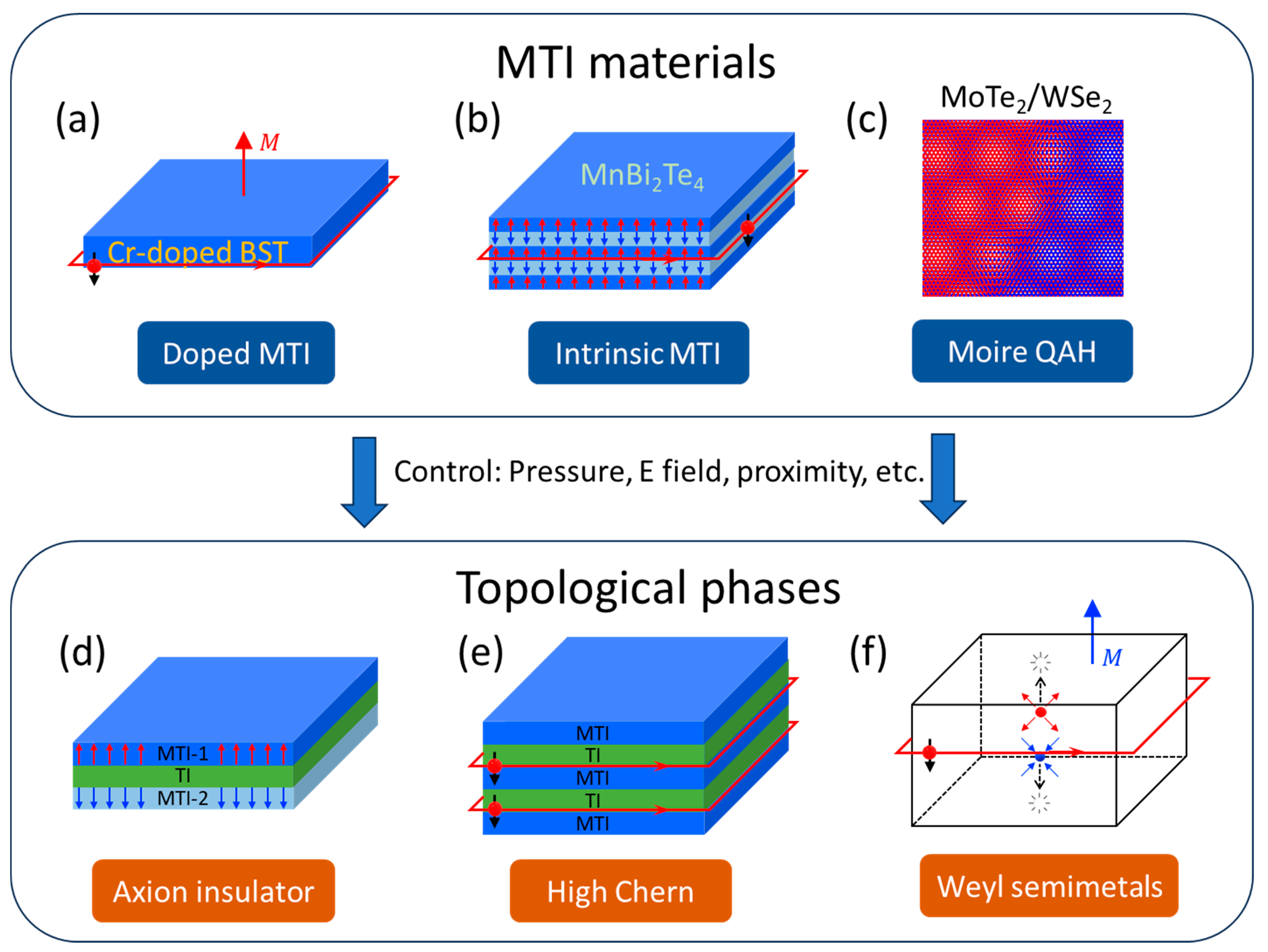
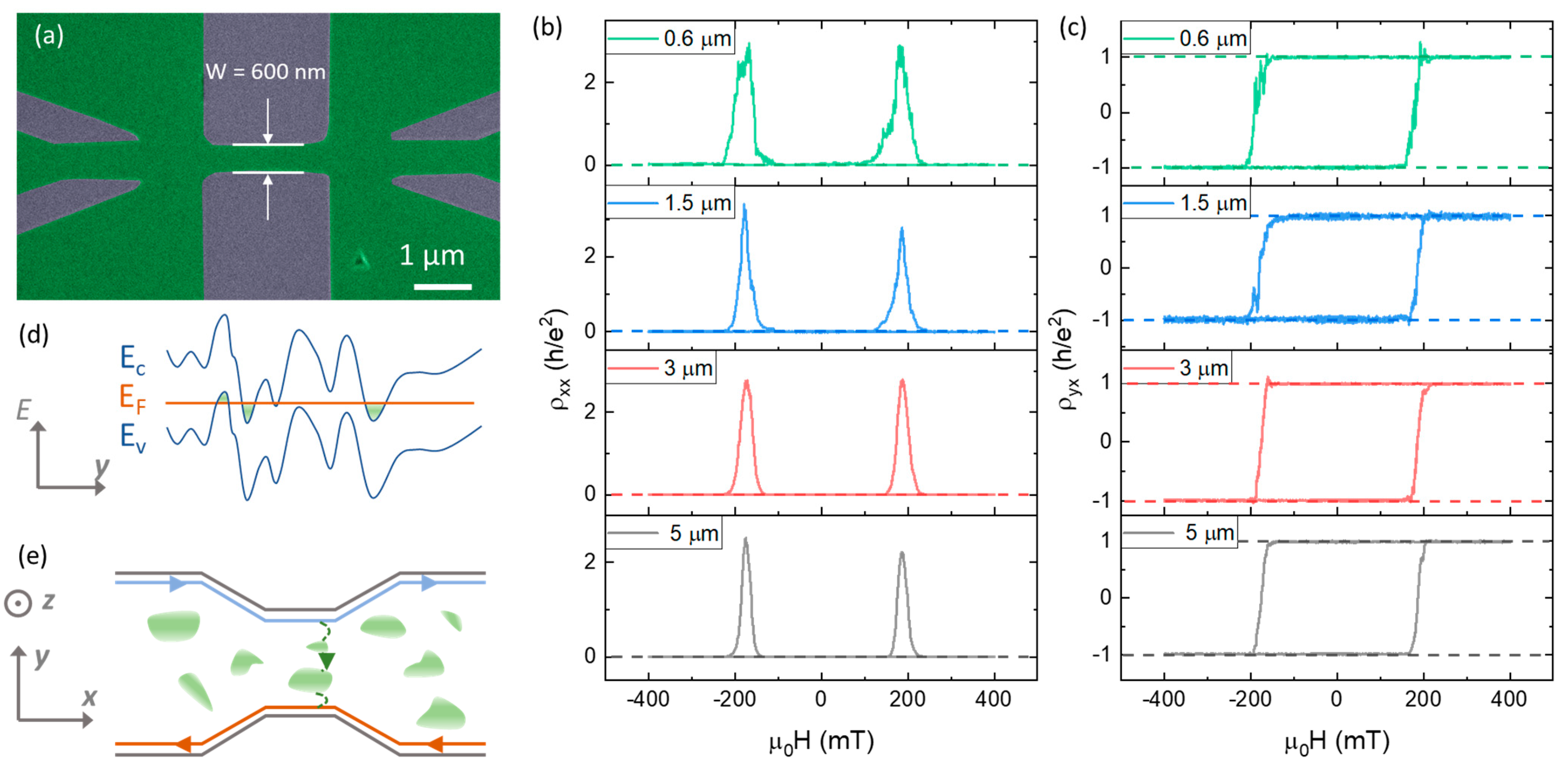
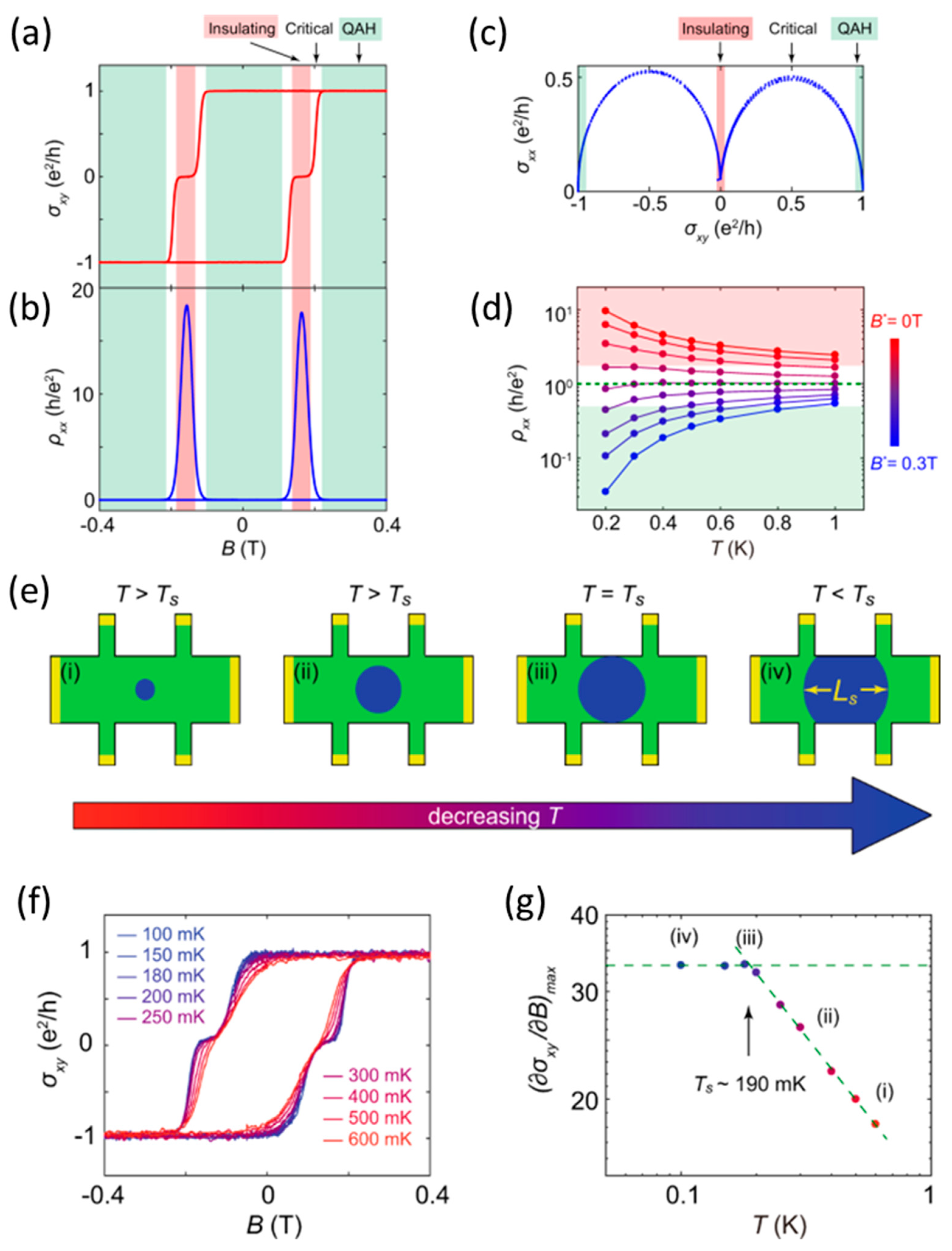
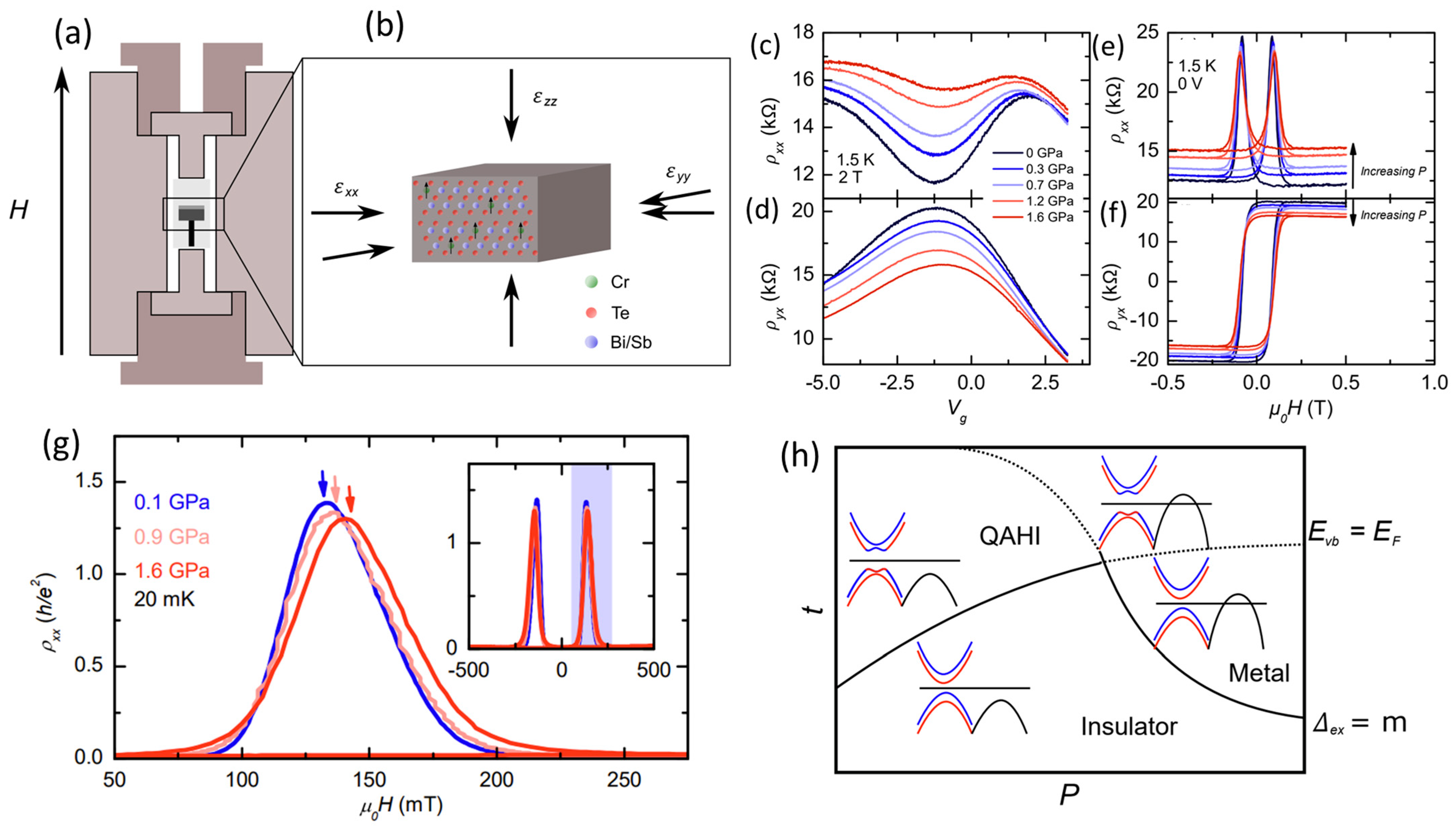
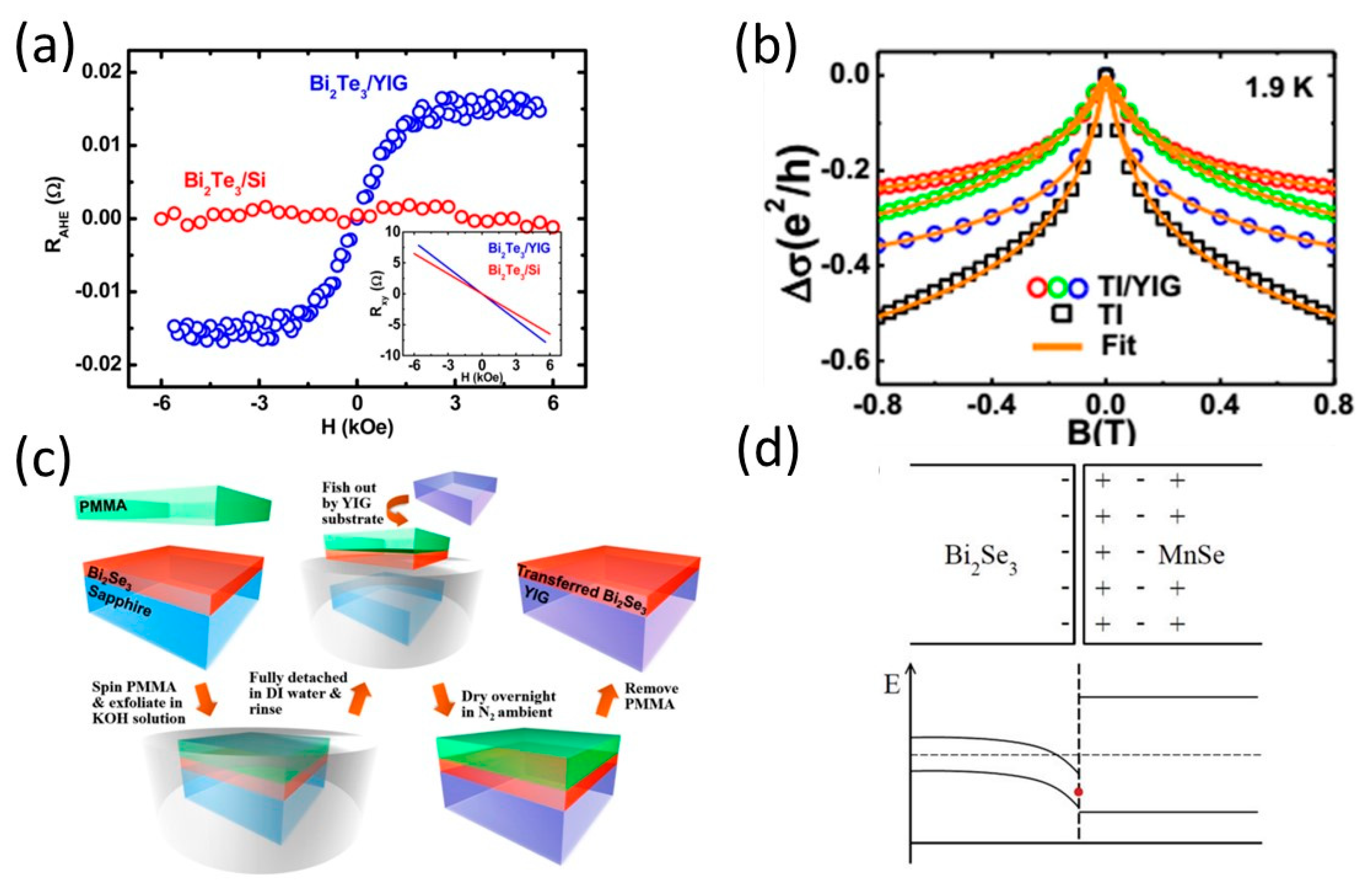
| Materials | Topology | ∆ (meV) | EC (V/nm) |
|---|---|---|---|
| InAs/GaSb | 2D TI | 3–9 | ~0.1 † [97] |
| Na3Bi | 2D TI | ~300 | 1.12 [98] |
| Graphene/WSe2 | 2D TI | ~0.25 | 0.02 [99] |
| h-BiSbTeSe2 | 3D TI | ~16 | ~0.25 [100] |
| (Cr,Bi,Sb)2Te3 | QAHI | ~0.04 * | 0.9 [40] |
| tMBG | Orbital CI | ~0.4 | ~0.45 [101] |
| MoTe2/WSe2 | QAHI | ~1.6 | 0.69 [18] |
Disclaimer/Publisher’s Note: The statements, opinions and data contained in all publications are solely those of the individual author(s) and contributor(s) and not of MDPI and/or the editor(s). MDPI and/or the editor(s) disclaim responsibility for any injury to people or property resulting from any ideas, methods, instructions or products referred to in the content. |
© 2023 by the authors. Licensee MDPI, Basel, Switzerland. This article is an open access article distributed under the terms and conditions of the Creative Commons Attribution (CC BY) license (https://creativecommons.org/licenses/by/4.0/).
Share and Cite
Qiu, G.; Yang, H.-Y.; Chong, S.K.; Cheng, Y.; Tai, L.; Wang, K.L. Manipulating Topological Phases in Magnetic Topological Insulators. Nanomaterials 2023, 13, 2655. https://doi.org/10.3390/nano13192655
Qiu G, Yang H-Y, Chong SK, Cheng Y, Tai L, Wang KL. Manipulating Topological Phases in Magnetic Topological Insulators. Nanomaterials. 2023; 13(19):2655. https://doi.org/10.3390/nano13192655
Chicago/Turabian StyleQiu, Gang, Hung-Yu Yang, Su Kong Chong, Yang Cheng, Lixuan Tai, and Kang L. Wang. 2023. "Manipulating Topological Phases in Magnetic Topological Insulators" Nanomaterials 13, no. 19: 2655. https://doi.org/10.3390/nano13192655
APA StyleQiu, G., Yang, H.-Y., Chong, S. K., Cheng, Y., Tai, L., & Wang, K. L. (2023). Manipulating Topological Phases in Magnetic Topological Insulators. Nanomaterials, 13(19), 2655. https://doi.org/10.3390/nano13192655





